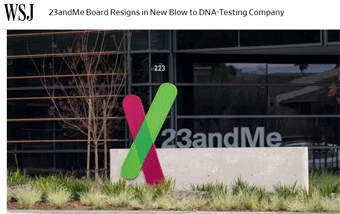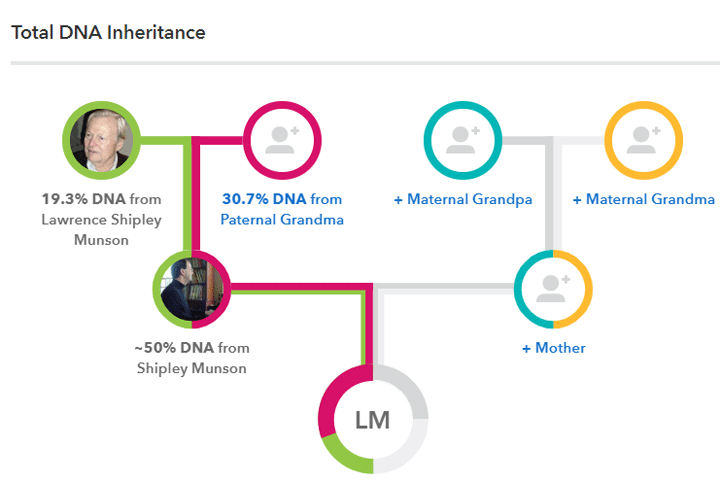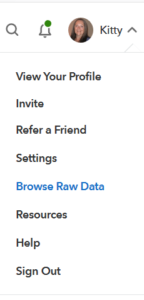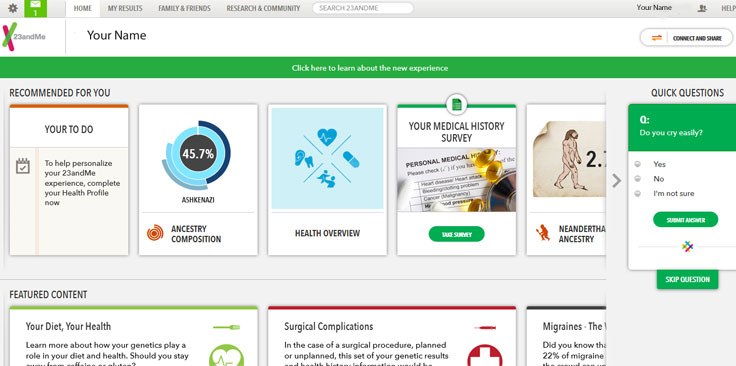Search Results for: 23andme basic
23andme Basics and an Update
My favorite capabilities at 23andme are: finding new relatives with DNA and comparing them in the chromosome browser, looking at my ancestry composition in depth, and having the ability to look up specific genes. Most of the recent changes at 23andme are to the ancestry composition tools, specifically there is more granularity in the areas it shows for your ancestors’ origins.
With three generations of Munsons on 23andme, thanks to my niece’s recent test, I can finally evaluate the GrandTree. This tool, found on the Family & Friends menu, lets you look at what you inherited from each grandparent. Not surprisingly my niece LM got way more from my mother, whose mother she strongly resembles, than from my Dad. There is no guarantee that you will get exactly 25% from each grandparent. In my case, I got more from my maternal grandfather which I deduce from my 28% jewish ethnicity.
This tool will look at the traits and health items tracked through the generations even if you did not buy the health reports. This will be discussed in more detail later in this article. Meanwhile, I will do a quick review of the current 23andme basics as a guide for my niece and any other new testers reading this.
Finding DNA relatives and comparing them in the chromosome browser
Click on DNA relatives on either the Ancestry menu or the Family & Friends menu to look at your cousin list. Here are my previous posts on this topic, still fairly accurate:
- Click here for my post on using the DNA Relatives match list. Note that the information your matches see about you can be changed or added to by clicking Settings in the drop down menu on the top right under your name and initials or picture if you uploaded one.
- Click here for my post on the page for a specific match and using the chromosome browser. Note that there is no longer a click point on the DNA relatives page to go straight to the chromosome browser. Instead just click on DNA Comparison on the drop down menu under Family & Friends.
- Click here for my discussion of the automated triangulation feature found at the bottom of the page for a specific match.
Looking up a specific gene
You can look up a specific gene or marker in the Browse Raw Data function which is found on the menu under your name. Click here for my blog post about the AIDS resistant gene which details how to do that type of look up.
Ancestry Composition
The great thing about the ancestry composition display at 23andme is that it shows you the details by chromosome. None of the other testing companies do that. What’s more if you put your cursor on a specific ethnicity, it will highlight just those segments on the diagram. Click on Ancestry Composition on the Ancestry menu to get to the page with the most details, including the chromosome by chromosome display.
Continue reading
23andme Basics – many posts
The Basics at 23andMe
My family members asked me to write a 23andme tutorial, so here it is. Let me know what else I should put here.
The three things most people like best at 23andme are learning about their health issues (currently disabled for new kits because of the FDA ruling), their ancestral places of origin, and finding DNA cousins (my term for people who share DNA that thus, must be related, however distantly). There is a wealth of other fun information available like how much Neanderthal DNA you have in you, but this post will mainly just cover those first three areas.
When you log in to 23andme you will see a page something like this.
You can click on Home in that top bar from any page on the site to return to this page. The ancestry composition box shown mid-page may not yet be ready for your sample if your results are just in.
To edit your profile, click on your name or photo on the far top right to get a menu with that option. If you have any messages the envelope at the top right will get a green background and show the number of messages you have as in the example below. Click on it to read them. I advise switching to email if you start to communicate with someone regularly as there are no tools to search the inbox unless you use chrome and the 23+ addon.
Continue reading
23andme: Now and Then
23andme started out by being a leader in the direct-to-consumer (DTC) genomic testing business. Time Magazine named it the 2008 Invention of the Year![1] It was the first place I tested my own autosomal DNA and that of many family members back in 2011-2012. Originally it had the best cousin matching tools, best ethnicity estimates, and had a well designed interface to examine the health implications in your own genome. Now I recommend to most that they start with Ancestry DNA and then upload that data to several other sites, including Promethease for the medical analysis, although 23andme still tests a wider range of health related genes.
 23andme has been in the news this week because its entire board, except its founder, Anne Wojcicki, resigned over her plan to take it private again. It went public in 2021 but has yet to turn a profit and the WSJ reports that it will run out of cash next year [ref WSJ]. However there is at least one company interested in buying it according to a post on the DNA-Newbie list.
23andme has been in the news this week because its entire board, except its founder, Anne Wojcicki, resigned over her plan to take it private again. It went public in 2021 but has yet to turn a profit and the WSJ reports that it will run out of cash next year [ref WSJ]. However there is at least one company interested in buying it according to a post on the DNA-Newbie list.
How should those of us who have tests there react to this news? Personally I am not worried, mainly because I hardly ever use the site anymore. I have long since downloaded my data and have contacted most of my closer matches. Roberta Estes has done a thorough blog post (click here) explaining how to save your data from 23andme.
The reason I rarely use 23andme is because it no longer allows you to compare your DNA to a relative in a chromosome browser; the feature I liked the best. I now do that at GEDmatch, Family Tree DNA, and MyHeritage. That tool was removed because of a data breach over a year ago where a hacker got lists of Jewish and Chinese testers and posted them for sale on the dark web. The break-in took advantage of users who had the same email and password on multiple sites, some of which had been exposed elsewhere.
Perhaps it is the resulting class action suit that caused part of 23andme’s financial woes. Click here for an article about how that is being settled with users.
My understanding was that the inspiration for the founding of 23andme was that Genia Brin, the mother of the then husband of founder Anne Wojcicki, was diagnosed with Parkinson’s in 1998 [ref michaelfox org]. The focus of 23andme has always been on discovering the genetic basis of various medical issues, not genealogy. However they have been quite supportive of adoptees (click here), since it is helpful to know what issues may lie in your DNA when you have no known family health history.
One way to look at the genetic basis of various diseases is to crowd-source lots of genomes.


